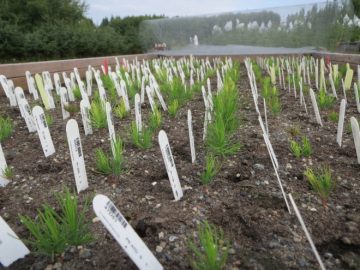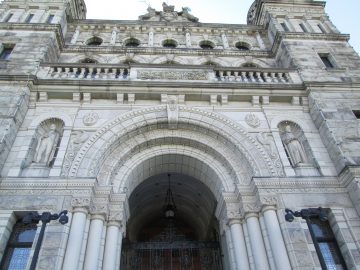Variety is the Spruce (and Pine) of Life

We often describe one another by a series of traits. You or I could be described by our height, body shape, eye or hair colour. The same is done with trees although some of the traits are different, we may describe trees by leaf shape or bark thickness. In tree species that live across large distances and different climates, it is not uncommon for populations to adapt to the local climate.
Local adaptation can mean many different things. Trees may be better suited to deal with cold in the north or heat in the south, more snowfall near mountain tops or drought in valleys. Local adaptation gives trees a better chance of survival and higher fitness in their associated climate. However, this means that they may not fare as well in other locations even those within the species’ range. As climate changes trees may become maladapted to their local climate.
Surveying the Social Landscape
Over 35 and 55 million hectares of forest are managed by the provincial governments of Alberta and British Columbia respectively. Management of these forests is controlled by provincial legislation and policy. Public perceptions and values can influence whether or not people support or reject policy and management decisions. The success or failure of policy is partially dependent on support from the public and leaders. As such it is important to understand the general public’s and community leaders’ perceptions of potential management strategies. As the goal of AdapTree is policy recommendations, we conducted an internet survey of these two groups in both BC and Alberta.
We worked with a sample that is representative of the general public. This included making sure we engaged a representative proportion of participants from urban centres and rural communities. We also invited elected officials and senior staff from forestry-dependent communities to participate. Potential participants were emailed links to a survey. While the general public were asked to share their own views, community leaders were asked to make choices they believed reflected their constituent’s views.
Seed, Breeds and Local Needs: The Effect of Artificial Selection on local adaptation
 Breeding programs are a major source of seed for reforestation in British Columbia and Alberta. In these programs trees are bred to be more economically valuable. This is done by improving traits such as height growth, stem volume, wood density and bug or disease resistance. Breeding programs, systems of artificial selection, control these characteristics by regulating the mating of parents. This works because qualities we see in plants, animals and people are the result of two things: inherited genes and the surrounding environment. For instance, hair colour is something we inherit from our parents but it may also be lightened by sunlight or affected by our health. By breeding together trees with desirable traits, seed orchards influence the inherited gene part of these attributes and produce seedlings with increased economic value.
Breeding programs are a major source of seed for reforestation in British Columbia and Alberta. In these programs trees are bred to be more economically valuable. This is done by improving traits such as height growth, stem volume, wood density and bug or disease resistance. Breeding programs, systems of artificial selection, control these characteristics by regulating the mating of parents. This works because qualities we see in plants, animals and people are the result of two things: inherited genes and the surrounding environment. For instance, hair colour is something we inherit from our parents but it may also be lightened by sunlight or affected by our health. By breeding together trees with desirable traits, seed orchards influence the inherited gene part of these attributes and produce seedlings with increased economic value.
What is the best policy?
Understanding the opportunities afforded by innovative management regimes, and seed transfer systems in particular, involves knowledge of the social, economic and political dynamics impacting implementation. While we researched social perceptions of those involved in and affected by forestry we also investigated the political setting in which our final recommendations will be put forth.
AdapTree researchers studied the institutional dynamics involved in forest stewardship and management practices in both British Columbia and Alberta. Through a qualitative program of study involving interviews with policy officials and stakeholders, supported by focus groups with practitioners, this research sought to identify core issues impacting the uptake and efficacy of climate-informed practice.